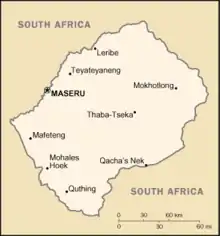1986 Lesotho coup d'état
The 1986 Lesotho coup d'état was a military coup that took place in Lesotho on 20 January 1986, led by General Justin Lekhanya.[1][2][3] It led to the deposition of Prime Minister Leabua Jonathan, who held the office since 1965 and assumed dictatorial powers in the 1970 coup d'état, after the general election was annulled.
 | |
| Date | 20 January 1986 |
|---|---|
| Location | |
| Type | Military coup |
| Motive | Regime change |
| Target | State House, Maseru |
| Organised by | Justin Lekhanya |
| Participants | Faction within the Defence Force |
| Outcome | Coup succeeds
|
General Lekhanya announced the creation of the Military Council, which would exercise all executive and legislative powers in the name of King Moshoeshoe II. Eventually, a power struggle developed between Lekhanya and the King, with the latter being forced into exile in the United Kingdom in February 1990,[4] and officially dethroned in December of that year.[5] Lekhanya himself was deposed in the 1991 coup d'état, led by Colonel Elias Phisoana Ramaema.[6]
References
- Alan Cowell (January 20, 1986). "MILITARY COUP REPORTED IN LESOTHO AFTER CRISIS". The New York Times. Retrieved January 13, 2022.
- Alan Cowell (January 21, 1986). "MILITARY TOPPLES LESOTHO LEADER; CAPITAL JUBILANT". The New York Times. Retrieved January 13, 2022.
- "Coup in Lesotho delights citizens -- and neighboring South Africa". csmonitor.com. Retrieved January 3, 2022.
- "Lesotho Strips King of Power". The New York Times. Reuters. February 22, 1990. Retrieved January 13, 2022.
- "Lesotho Army Ruler Declares Exiled King to Be Dethroned". The New York Times. Associated Press. November 7, 1990. Retrieved January 13, 2022.
- Christopher S. Wren (May 1, 1991). "Lesotho's Military Leader Ousted by Army Officers". The New York Times. Retrieved January 13, 2022.